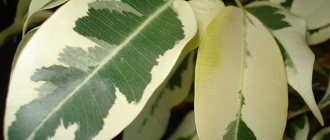Ficus is a fairly popular indoor plant. Most often you can find Ficus Benjamin in homes and offices. It does not require special growing conditions, which is why it is so loved. But in order to maintain its decorative qualities, you need to provide it with adequate nutrition. Properly selected fertilizers for Ficus Benjamin and timely fertilizing will help preserve the beauty of the plant.
Conditions for proper development
Ficus benjamina feels good in a spacious pot. This does not mean that you need to immediately plant it in a flowerpot, you just need a pot where the plant will freely take root. At the same time, the ficus does not like frequent transplants and changes of place of residence; for this it needs constancy. He reacts to all changes with protest - he sheds his leaves.
The plant needs moderate watering, always with warm, settled water. Excess moisture and low temperatures lead to rotting of the roots. Therefore, excess water that has flowed into the pan must be drained immediately.
The shower for Ficus Benjamin should also be warm, and after that the leaves should be wiped with a damp cloth. Otherwise, dusty stains will remain on the leaves, and the plant does not like this.
Briefly about ficus
Ficus plants have certain growing characteristics. Ficus benjamina, ficus rubber (elastic) and other species of the family do not tolerate constant transplants and changes in habitat. It is necessary to place the plant in one place and try to disturb it as little as possible. The soil needs to be enriched with humus and peat, and expanded clay and charcoal should be used as a leavening agent. Ash can be used as fertilizing and at the same time protection against pests.
Plants do not tolerate excessive watering, so it is important to adhere to the norm - do not allow the soil to dry out in summer, and do not overwater the plant in winter. Stagnation of water in the pan is a signal of excess moisture. It is necessary to drain the liquid, otherwise the root system will begin to rot. If your pet's leaves begin to turn yellow, this may indicate a lack of moisture. Fertilizer for ficus should be selected in accordance with the condition of the plant and its development.
Nutrition needed by ficus and signs of its deficiency
To know exactly what fertilizers are needed for Ficus Benjamin, you need to understand what the ficus eats.
For the proper development of a plant, it needs various macro- and microelements. There are 13 of them in total, nitrogen is considered the main one. It is nitrogen that forms the green mass and is responsible for the rich color of the leaves. Thanks to it, photosynthetic processes proceed normally.
Ficus also needs:
- In phosphorus, thanks to which the root system of the plant grows and develops and resistance to diseases increases.
- Potassium, thanks to which the plant tolerates short-term droughts well.
- Calcium, which improves the metabolic processes of the flower.
These are the main elements; additional elements include magnesium, manganese, sulfur, iron, zinc, copper, molybdenum, cobalt, and boron.
When the soil begins to lack certain nutrients, the flower starves. This can be seen by the following signs:
- Growth slows down and then stops completely.
- The stems stretch and become thin.
- The leaves become pale and yellow spots appear.
- The elasticity of the leaves is lost, they can dry out and die.
- The plant's immune system begins to work poorly, so susceptibility to disease increases.
- Low resistance to pests.
Feeding Ficus Benjamin should be done regularly until the above signs begin to appear.
The ficus will also react to excessive fertilization: it will shed its leaves and the soil will become covered with a white coating.
How to properly feed ficus benjamina
Fertilizers are needed for the active growth and development of the plant. This is especially important during the growing season.
In summer, the flower needs to be fed with nitrogen-containing fertilizer. After this, the growth of deciduous mass will begin. This feeding is also suitable for rehabilitating a damaged plant.
Since this flower is quite tall (at home it grows up to 3 meters), fertilizers for Ficus Benjamin should be varied. You can purchase ready-made fertilizers in specialized stores or prepare them yourself at home.
Before feeding, you need to make sure that the ficus does not become crowded in the pot. As usual, it is replanted once every 4 years, when the roots completely entangle the soil in the pot. It is best to replant ficus in spring or autumn when it is warm.
It is not necessary to prepare the soil for replanting yourself; it is easier to purchase a special soil mixture for ficuses in the store. In special soil the plant will take root faster.
Fertilizers for Ficus Benjamin will depend on several factors: soil, age of the plant, season. For example, if the substrate does not contain soil, it means that it contains absolutely no nutrients, and in this case, fertilizing is carried out all year round. Conventional soil mixtures are periodically fed with organic or mineral fertilizers. As a rule, fertilizing is carried out in the summer, every two weeks.
3.Humidity and air temperature
These parameters differ for ficuses with different leaf colors. Ficuses, which have light green, monochromatic foliage, prefer a temperature of about 23 degrees in summer, and about 19 degrees in winter. Ficus Benjamin will not tolerate temperatures below 12 degrees and above 25 degrees.
Ficus benjamina with variegated foliage requires higher temperatures, approximately 28-30 degrees in summer and not lower than 15-16 degrees in winter. Dry air is very harmful to ficus; you should not place it close to heating devices in winter. The leaves will begin to fall off and the ficus will lose its decorative effect.
To help the plant, you need to maintain air humidity by any available means. For example: using humidifiers or regularly spraying the leaves with warm water, the more often the better, especially on hot days.
It is useful to take a warm shower once a week, both in summer and winter, to maintain good plant health. By the way, this will be a good prevention against pests such as scale insects and spider mites.
How often to feed ficus
Fertilizing ficus benjamina at home is not done as often as other house flowers. But at the same time, the amount of nutrients should be sufficient for proper nutrition.
The larger the plant's canopy, the more nutrients it will need. In about two months, the ficus completely depletes the soil.
Intensive feeding will be required during the active growth of the plant - in the spring and summer.
The last time fertilizing ficus at home is carried out at the end of September. When cold weather sets in, the ficus goes into a dormant state and all processes slow down. The need for nutrition is reduced; there is no need to fertilize it during this period.
If the room where the ficus is grown is warm and light enough, fertilizing can be continued, but the rate and frequency must be reduced.
What kind of fertilizers are there for ficus benjamina?
Based on their origin, fertilizers are divided into two main types: mineral and organic.
Mineral fertilizers are inorganic compounds that are produced industrially. They contain a very high concentration of useful substances, which means they will give a positive effect faster.
Organic fertilizers are the decomposing remains of plant and animal organisms. They nourish plants well, improve soil, and improve the functioning of beneficial microorganisms, but their action is slower.
The best fertilizer for Ficus Benjamin is alternating mineral and organic fertilizers. This approach will provide the flower with the necessary nutrition for full development.
Mineral fertilizers
Today there are quite a few different fertilizers specifically for Ficus Benjamin. They contain minerals in the right ratio.
All drugs differ in the form of release:
- Dry - in powder, tablets, granules. Solutions are prepared from them or placed in the soil. In the latter case, they gradually dissolve when watered.
- Liquid - they are used to carry out root and foliar treatment of plants. They are distinguished by their fast action.
- Sticks - they are loved for their prolonged action (up to several months). Place next to a flower in a pot. Allows you to save time on caring for the plant.
Ready-made preparations for baiting
You can purchase fertilizers for ficus benjamina in specialized stores. These can be both complex fertilizers that are suitable for any house plants, and those that are aimed exclusively at improving the growth of ficus plants. You can purchase both the first and the second. Flower growers often opt for preparations with a wide range of applications, so that they can use fertilizer for several home flowers at once.
One of the universal fertilizers, which can be used not only for indoor plants, but also to increase the yield of garden crops, is the BioGrow biofertilizer. This is a drug that has proven itself to be a highly effective revitalizing agent, as a result of which plants begin to develop noticeably faster, the green part is strengthened, and the flower’s resistance to fungal infections increases. find out more information and purchase the universal biofertilizer “BioGrow” HERE .
Other effective narrow-spectrum agents:
- "Agricola". A universal fertilizer that works effectively with all types of ficus. It has a beneficial effect on the growth of large leaves and their rich green color.
- "Flower heaven". Liquid fertilizer. Sold in plastic bottles. As reviews indicate, ficus trees begin to grow faster and become stronger. The drug is odorless and inexpensive.
- "Bona Forte". Fertilizer for ficus and palm trees. Can be used for both root and foliar feeding. Priming significantly accelerates the growth and improves the appearance of houseplants.
- "Rainbow". Preparation based on vermicompost. Promotes the development of the plant's root system and strengthens the stems.
- "Pokon" Complex fertilizer, liquid form. Designed specifically for ficus trees, produced in Holland. Suitable for all types of the family. The composition is odorless and completely dissolves in water.
All diluted compositions for fertilizing must be used immediately; they cannot be stored.
The most popular fertilizers for ficus that are easy to use at home
- Humus of animal origin is a natural source of nitrogen. It is this fertilizer that is used for ficus benjamina to thicken the leaves. The most beneficial substances are found in bird droppings. Bird droppings products are even superior to manure. They act very quickly, almost like mineral fertilizers. It must be remembered that bird droppings are used only in the form of a solution. Ficus Benjamin can be fed with humus from the manure of cattle, horses, pigs, etc. It is also used in the form of a solution.
- Plant humus - in this case, plant debris decomposes. This fertilizer has many essential microelements, and a solution is also made from it.
- Nettle. Nettle fertilizer contains elements such as nitrogen, potassium and magnesium. It is used to strengthen the root system, accelerate plant development, and improve soil condition. Leaves and stems must be prepared in advance, before the seeds appear on the nettles. Fill half a plastic bottle with nettles, add water and leave to ferment for 2 weeks. The result is a dark green liquid, which is diluted with water for use. Ficus should be watered with a solution in a ratio of 1:10, and sprayed with a solution of 1:20. The proportions should not be violated, as you can burn the leaves and roots.
- Wood ash. It contains quite a lot of different elements, including potassium and phosphorus. An infusion is made from ficus ash: 1 tsp. ash is poured into 1 liter of boiling water and left for 7 days. This infusion is used to water the flower. Also, to protect the plant from pests, you can dust the leaves with ash.
- Succinic acid. If Benjamin's ficus sheds its leaves, fertilizer is usually not required for it; this is a reaction of the flower to external stimuli, such as frequent replanting, change of residence or improper care. If there have been no changes in the life of the flower, you can feed it with a crystalline colorless substance - succinic acid. It promotes flower growth, increases its vitality, and improves soil microflora. To fertilize, you first need to prepare a concentrate: dissolve 1 g of succinic acid in 1 liter of water. For spraying leaves, this concentrate is diluted with water in a ratio of 1:1, for root watering - in a ratio of 1:4. It is recommended to feed ficus with succinic acid once a year; the finished concentrated liquid is stored for no more than 3 days.
Thus, fertilizers for Ficus Benjamin at home can be completely different, the main thing is to accurately observe the proportions when using them.
Answers on questions
How to feed a ficus if the leaves turn yellow and fall off? Feed in summer
plant once a month; in winter it is better to neglect the procedure.
be fed
during the period of active growth, from spring to autumn. Mineral and organic fertilizers are added to the soil with water.
How to feed ficus in spring and summer
Ficus plants need to be fed in spring and summer due to the active growing season of the plant during this period. It is necessary to help the flower grow green mass and gain a foothold in the soil. To do this, you need to enrich the soil with nitrogen. Both organic and mineral fertilizers are suitable, but it is better to alternate them rather than apply them at the same time.
How to feed ficus in autumn and winter
In winter, when daylight hours are shortened, the plant's growing season stops, so there is no need for frequent feeding. You can only periodically water the flower with a low-concentrated nitrogen fertilizer, but only if the ficus grows in conditions close to summer - a certain humidity level, warm air, an additional light source.
How to feed a ficus if it drops its leaves on its own
If the leaf drop is not caused by disease or pests, the cause may be soil depletion. The plant cannot obtain all the components necessary for life. As a result, the foliage loses turgor and falls off, and the crop may even die.
Important! To return the flower to its former beauty, you need to replace some of the soil in the pot with fresher one. To increase plant resistance, the preparations Epin or Zircon are used. The leaves are wiped with a liquid solution.
How to feed ficus for growth
To
improve
growth
feed
the ficus with solutions of organic fertilizers in the form of bird droppings and animal waste products. Animal humus is a classic organic matter, which is the most effective of its kind among nitrogen fertilizers for plant crops.
Also ficus
You can
feed it
with regular baker's yeast.
They contain quite a lot of nitrogen and serve not only as a fertilizer, but also as a growth
. Used for watering at the root and spraying the above-ground part.
What to feed to make leaves thicker
To increase the density of the crown, it is recommended to use succinic acid. These are colorless crystals that dissolve in water. The ficus is watered with a liquid mixture or the crown is sprayed.
Succinic acid prevents the shedding of leaves and their withering, strengthens the roots of the plant, and stimulates the development of the crown. To prepare the solution, mix 1 g of acid and 1 liter of water. Add to the root for three days. The procedure is carried out once a year.
Root feeding
Root feeding is watering the plant with nutrient solutions and is the most common method. But in order not to harm the plant, this procedure must be carried out wisely. It will benefit the flower if you adhere to the following rules:
- Read the manufacturer's instructions and follow them exactly. The dosage can be adjusted according to the appearance of the ficus.
- Sick plants do not need to be fed - in this state they do not absorb nutrients. The flower must first be treated with fungicides and wait until it has fully recovered.
- It is not recommended to feed the ficus immediately after transplantation; you need to wait 20-30 days for the plant to adapt and restore damaged roots.
- To prevent burns to the ficus root system, all fertilizing is applied only to moist soil.
Fertilizers for root feeding can be different: both dry and liquid. It is important that the composition is evenly distributed throughout the pot so that all roots receive nutrition.
Kinds
Ficus fertilization is carried out with both organic and mineral products.
- waste products of birds and domestic animals;
- vegetable compost mixtures.
Mineral supplements mean chemical compounds:
- rock minerals;
- salt;
- industrial waste.
Application frequency
Ficus feeding is carried out infrequently
They should be plentiful, this is especially important for mature plants that have an extensive leafy crown
Large ficus plants greatly deplete the soil in the pot. To eliminate this problem, you need to add nutrients.
The mode and rate of fertilizer application depends on the time of year:
- In summer and spring the interval is 10-14 days.
- In winter, ficus is not fertilized.
Methods of application
The plant is fed by root and non-root methods.
- The first contributes to the normal development of the root system.
- Foliar foliar helps strengthen the plant’s immunity and protect it from the development of diseases.
- Foliar feeding can be carried out by “dusting” the plant. This procedure helps get rid of pests and diseases.
- The second option for foliar fertilizer is exposure through the soil. In this way, you need to apply drugs during the period of active growth - from spring to mid-autumn. The nutrient mixture is applied to moist soil.
Foliar feeding
Ficus plants also love foliar feeding. Through the leaves, nutrients are absorbed faster by plants. Often, foliar treatment is used in emergency cases when the roots cannot take nutrition from the soil. This procedure works very quickly, and the result is visible immediately. But solutions for spraying leaves are very weak, so they cannot completely replace the main feeding.
To maximize the effect of the treatment, it is important to carry it out correctly. The leaves need to be sprayed with a spray bottle, always on both sides. At the bottom of the leaf there are more stomata, through which the fertilizer will be absorbed.
It is very important to prepare the solution for treatment correctly, that is, not to exceed the recommended dosage. Fertilizer can burn the leaves, then the ficus will get sick and die.











